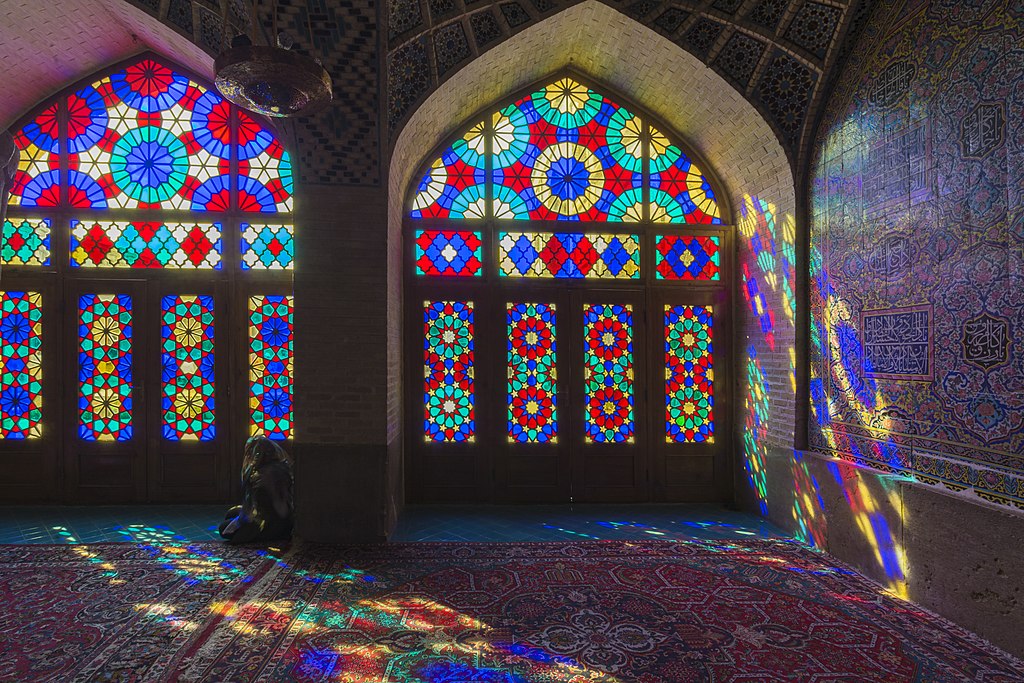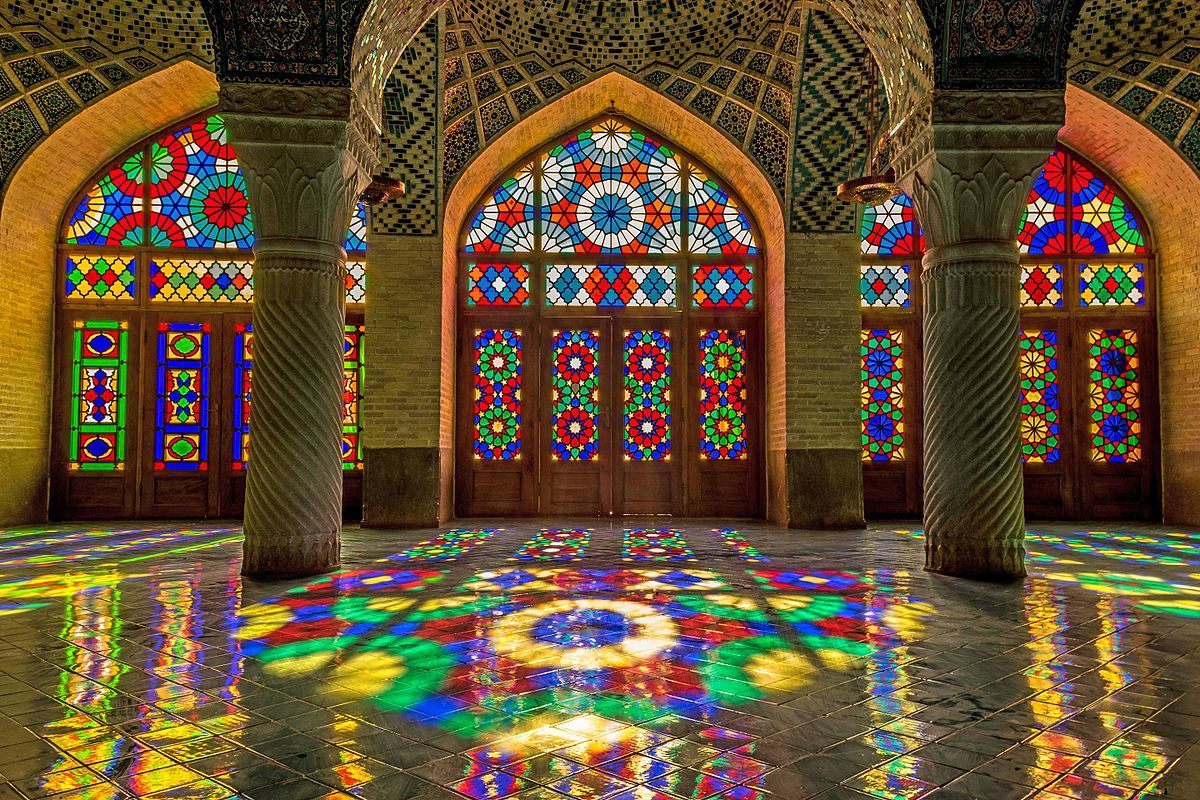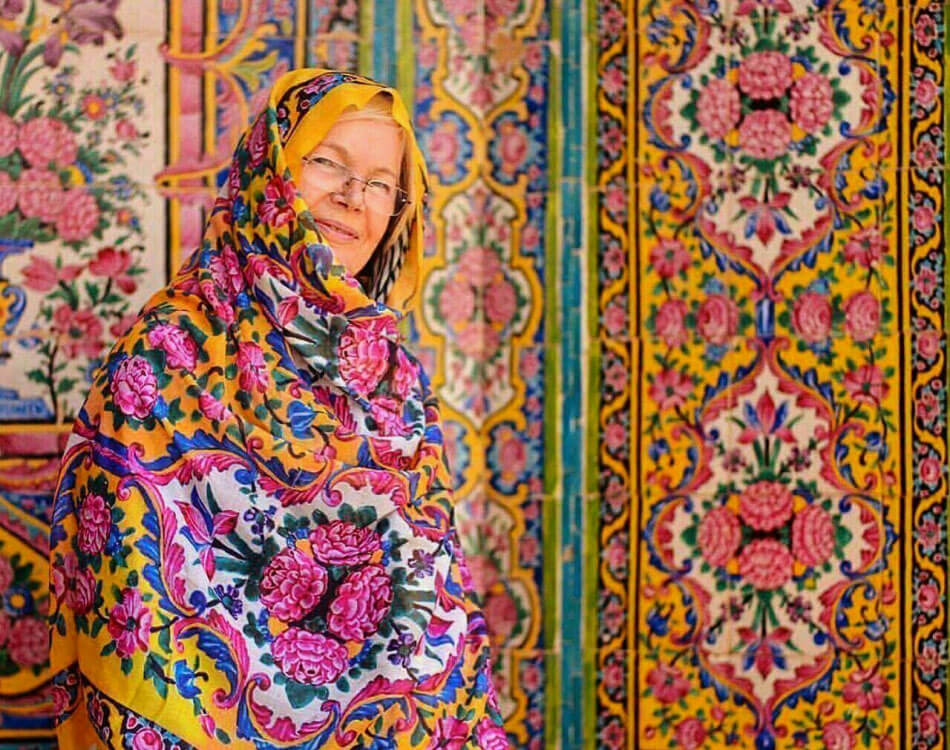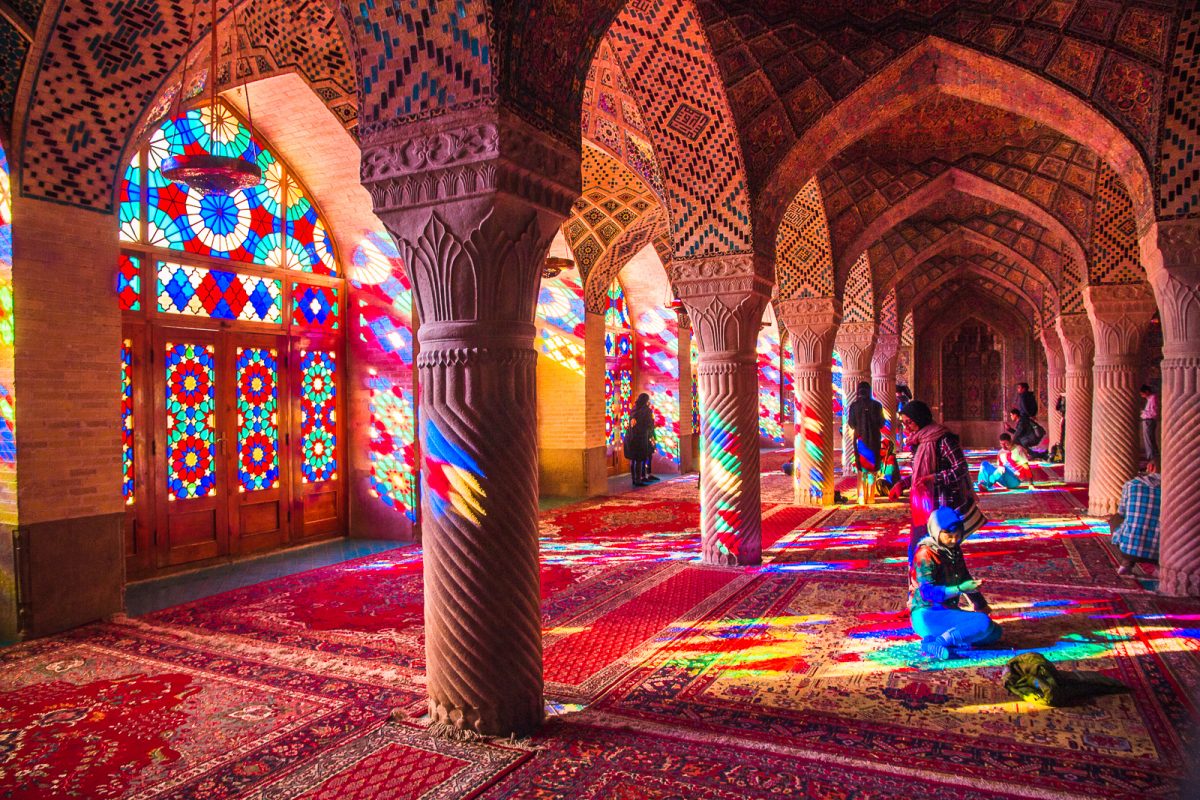Copyright 2020 - 2021 irantour.tours all right reserved
Designed by Behsazanhost
Nasir ol Molk Mosque Shiraz
Nasir ol Molk Mosque Shiraz
Nasir ol Molk Mosque or Pink Mosque is the most famous place among all tourists for its pink outlook a unique historical site in Shiraz; an attraction that is famous for its pink outlook and takes everyone by surprise. The tile work, Glasswork, and decoration of the Nasir-Ol-Molk Mosque are so beautiful, eye-catching, and elegant that they can amaze and marvel at the visitors for hours. A photo of this colorful Mosque encourages any viewer to visit it. The spectacular and marvelous design of this building will be admired by every viewer.
 |
Why it is known as the pink mosque?
The beautiful design and decoration of the mosque in the main Ivan with the colored glass in its old windows(Orsi) create one of the best color combinations that are unique in their kind. The use of pink color in the tiles of this mosque with nice tiling and Muqarnas has made it more spectacular and famous, now it is a valuable popular place for Memorial photo and also is changed as the characteristic mark of Shiraz among the tourists.
What does Nasir Ol Molk Mosque look like?
This mosque is situated in one of the old neighborhoods of Shiraz, this beautiful mosque is known as one of the architectural highlights of this city that dazzles every viewer. When you are visiting this mosque its visual and spiritual beauties simultaneously will take you into the deep richness of the religious architecture of Iran.
When you open the great wooden masterpiece entrance door and cross among the vestibule and arrive at the rectangular yard, everything looks like any other mosque in Iran; beautiful tile designs, rectangular pillars between the courtyard, a marble pool with a jet of water, and anything else that is normal in a mosque in Iran.
Two important things keep this mosque distinct from other Iranian mosques.
 |
1- Westernization of the mosque
With the rise of the Qajar dynasty, European culture became more and more popular in Iran. Many elementary and secondary schools have been built by Britain, Austrian, and France throughout Iran to promote European ideology and culture. Naser al-Din Shah the most famous king of the Qajar dynasty, who ruled Persia from 1848 to 1896, was strongly influenced by European culture. He ordered to build off the Dar ul-Funun College (Persia) in Tehran, which was founded in 1852 to teach European languages and technical subjects, including photography and lithography. With this wave of European missionaries, Iran was influenced by Western culture, and one of the most prominent was using Western-style colored tiles in Iranian architecture.
Although Persia was known for its production of glazed tiles of geometric shapes and their use in mosques and shrines, mainly observed in the architecture of Isfahan, the production of tiles in Iran fell sharply in the 18th century. The Qajar period came with the revival of the production of tiles alongside the importation of tiles with floral patterns and bright colors from factories in Great Britain, France, and Germany. Tiles imported from Europe were characterized by representations of landscapes, European architecture or beautiful women and were widely used in the interiors of residential houses and palaces during the Qajar period. The Nasir al Molk Mosque was built at the height of westernization in Iran. We see many representations of Western architecture on tiles displayed on the interior walls of the mosque as well as strangely bright colored designs defining the mosque only from the original Persian architecture seen in the 13th and 14th centuries. Although the iwan of the mosque is very similar in structure to the original iwans seen in many Persian mosques, such as the Shah Mosque (Isfahan), in the Nasir al Molk Mosque, the iwan is designed with floral motifs in bright colors rather than geometric shapes of turquoise color. The floral patterns and western architectural representations on the walls of the mosque are an undeniable important feature of the mosque showing the Western influence on Islamic Iran in the 19th century.
 |
2- The dance of light among the colored glass
Although stained glass is mainly popular in churches these days, the first discovery took place in Syria in the 7th century. Orsi windows are windows made of a mixture of wood and colored glass in the Safavid and Qajar dynasties. Orsi differs from the stained glass windows used in many Ottoman churches and mosques that serve as illuminated images rather than a source of light. Light is a major feature in many mosques since it is a major symbol of God in Islam. This is mentioned in a chapter of the Qur'an:
"Allah is the light of the heavens and the earth"
Orsi in the Nasir al Molk Mosque creates a major definitive characteristic that makes up the colorful spiritual feeling of fear in the visitor upon entering. The main purpose of Orsi is to create a colored light inside the building. The mosque has seven colorful Orsi wooden doors connecting the interior mosque to the courtyard. Orsi windows are characterized by using geometric shapes in their designs due to the prohibition of images and icons in Islamic art.
 |
The history of the Nasir Ol Molk mosque
The Nasir-Ol-Molk mosque was built on an area of 2,890 square meters and covers an area of 2,162 square meters. One of the hallmarks of the Nasir-Ol-Molk mosque is its tiles and Muqarnas and is considered to be the most precious mosque in Iran. Interestingly, there is no dome in this mosque, which indicates that this religious building was fairly personal and was not used by the public.
In 1914, the sovereign or ruler of Fars, Mirza Hassan Ali Khan, known as Nasir-Ol-Molk, decided to build a charity mosque. Based on the inscriptions on the front door of this building, Haj Mohammad Hassan Memar and Mirza Reza Kashi Gar designed the mosque. The cost of this mosque was covered by the Khums and Zakat( The Islamic Tax).
It was completed after 12 years from the start of construction, in the year 1925, but there were no colored glasses. The colorful windows and doors were made in 1969 by Haj Mirza Ayat. The complex had just a mosque, a house, a bath, and a warehouse, but a large part of it included the Andaruni.
The tiling of the mosque is very unique and is not visible elsewhere. One of the main characteristics of its tile work is the pink color as the dominant color which is not usual in any other Iranian mosque. The structure of the main hall and the use of colored glass are also considered to be the enchanting effects of this mosque.
The mosque has two main bedrooms facing each other.
Eastern Shabestan and Western Shabestan. The eastern part of this mosque, which is the most beautiful part of it, has the most beautiful tile-work and Islamic ornamentation with colorful stained glass windows that is the highlighted part of the mosque. The various arts used in this mosque, such as the tile-painting mosaic and the unique altar, make this place a stunning sight for anyone. The harmony between the columns, the fantastic geometric patterns, the play of light and colors, and the splendid Muqarnas dazzle the eyes of visitors and photographers. The mosque has large elements of traditional architecture such as a central fountain, an iwan, a panj kāseh-i (five concaves), earthenware, and plaster works.
The Nasir al-Mulk Mosque has been listed as one of the national heritage sites of Iran and attracts many travelers to Iran every year. The best time to visit the mosque is early in the morning and from 8 to 9 am. It's the best time to see the light pass through the stained glass windows and create a kaleidoscopic space that entertains travelers, photographers, and the faithful. The interesting point is that the Nasir al-Mulk mosque is still used for worship. Today, this glorious mosque is under the protection of the Nasir al-Mulk Endowment Foundation.
 |
Take photos at Nasir Al-Mulk Mosque
The photos are seen above and below do not do justice to the beauty of the mosque, the view is much more spectacular and magical in real life. However, it is understandable that you want to capture these wonderful and unique moments, too, and to be fair, the rainbow of colors and the beauty of light here is a dream to photograph for many photographers. To get the best shots of the mosque, here are some tips:
Show up early - check with your hostel, hotel, or guesthouse for the exact opening hours of the mosque, so you're one of the first to show up. In the morning, it is also when the light hits the windows completely, creating these patterns of rainbow colors inside. Don't wait for the curtains to open - Try to take your photo at first.
Thick curtains cover the mosaic stained glass from the outside to protect the windows and the wood but blocking most of the incoming light.
Many people enjoyed admiring the mosque from the outside, waiting for the curtains to open fully to see the big show. It means having the interior of the mosque for you for a short time, creating these empty, but nonetheless beautiful, photos, as light always penetrated through the top of the windows. Even after you start opening the curtains, only half of them have been opened, so don't wait, take advantage of every opportunity you have.
 |
Respect others - as much as you like taking pictures, there are 10 if not 20 or 30 people who would like the same. We live in this time when everyone has a camera, although on their phone or having a camera, and everyone wants a photo. Respect the other people who take their photos, wait for your turn, and you will most likely have the opportunity to do the same otherwise, it is always the opportunity to ask politely. Do not sit in the middle of the room to just relax when you are finished taking your photos, let others do the same so that everyone leaves happy and with their perfect photo. To give you a better idea of the number of people present, check out the photo below that I took just after the curtains were fully opened.
Changing the angles - It will be difficult to have the mosque entirely for you, however, it is not impossible to change the angles and create the appearance that you make. Instead of photographing the whole room, take a section of windows instead, while getting those beautiful photos with that perfect image.
- Details
- Category: Museums of Shiraz
















